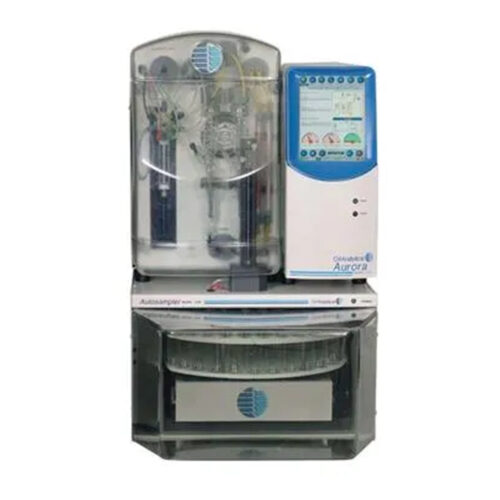1080
Total organic carbon (TOC) measurement is a well-established technique that provides valuable information about water quality for process control and regulatory compliance. Though high-temperature combustion TOC has been shown to be very effective for the analysis of samples that are of high molecular weight or contain substantial amounts of salt or difficult-to oxidize organics (e.g, humic acid), these types of samples are problematic for combustion TOC analyzers.
Kenmerken
The 1080 TOC Analyzer processes aqueous samples for analysis of the total organic carbon (TOC), total inorganic carbon (TIC), and non-purgeable organic carbon (NPOC) content. Supporting USEPA-approved methods, Standard Methods, ASTM, DIN/ISO/CEN, and EU Methods our 1080 can analyze up to 300 samples per 24-hour period, depending upon the protocol employed, in excess of 100,000 samples per year. Principal applications include wastewater, seawater, industrial process water, drinking water, groundwater, and cooling water.
The 1080 TOC employs a multi-step analysis technique to distinguish and quantify different forms of carbon present in sample matrices and determine TOC content. The value reported as TOC is the non-purgeable organic carbon (NPOC) content. NPOC is derived by first determining, or sparging, the TIC content of a sample and then introducing the TIC-free sample into the combustion reactor to oxidize organic compound constituents.
TIC concentration is determined by acidifying a sample to a pH less than 2. Carbonates and bicarbonates in the sample dissociate, forming CO2, which is measured by a solid-state non-dispersive infrared detector (SSNDIR) and reported in mass and concentration values.
TIC-free samples are Pulse-Timed injected into the reactor to perform high temperature (680 ºC) combustion over a platinum catalyst. Organic compounds are oxidized and converted into CO2, which is then quantified by the SSNDIR detector. The result is reported as the TOC content in both mass and concentration of carbon.
The 1080 TOC Analyzer also supports other analytical approaches — including TC, TOC by subtraction (TC-TIC), and simultaneous determination of total bound nitrogen (TNb) using the optional TNb analysis module.
Model 1080 Features
- Wide operational range (50 ppb –2,000 ppm C)
- Supports TC/TIC/TOC/NPOC analysis techniques and standard measurements
- Patented* Smart Slide injector extends o-ring life and reduces maintenance
- Patented* Tube Guard extends furnace tube
life, and reduces maintenance
Total organic carbon (TOC) measurement is a well-established technique that provides valuable information about water quality for process control and regulatory compliance. Though high-temperature combustion TOC has been shown to be very effective for the analysis of samples that are of high molecular weight or contain substantial amounts of salt or difficult-to oxidize organics (e.g, humic acid), these types of samples are problematic for combustion TOC analyzers.
With over 45 years of experience in designing TOC analyzers, OI Analytical brings game-changing technology to combustion TOC analysis for the accurate results you need with a low cost of ownership and unprecedented ease of use and maintenance. Engineered for unsurpassed reliability and simple operation, the Model 1080 Total Organic Carbon Analyzer handles even the most challenging applications without the need for expensive additional kits, modules, or special options.
Test Methods Supported:
The high-temperature combustion technique has been approved and adopted in numerous regulatory compliance methods, standards, and norms for water quality testing.
USEPA 415.1 – Drinking Water
Standard Method 5310B – Wastewater, Ground & Surface Waters
USEPA 9060A – Wastewater, Ground & Surface Waters
USEPA-DBPR – Disinfection Byproduct Rule
ISO 8245 – Drinking Water & Wastewater
EN 1484 – Surface & Ground Water, Potable Water
ASTM D7573-09 – Water, Wastewater & Sea Water
Designed for Performance and Simplicity
High-temperature catalytic combustion oxidizes and converts the organic compounds present in aqueous samples to CO2 for measurement by a solid-state, non-dispersive infrared (SS-NDIR) detector. Patent-pending technologies protect the catalyst, increase reliability, reduce maintenance and operating costs, and extend the life of the instrument
Automation
The 1080 TOC also offers automatic sample acidification and sparging. The automatic dilution function reduces sample salinity, acidity, and alkalinity, significantly extending the dynamic range.
Priority Sample on the Fly & Increased Throughput
With intuitive software features, priority samples can be added at any time without interrupting the operation of the instrument. The Model 1088 Autosampler analyzes up to 88 samples unattended freeing the operator’s time for other projects.
Compact Design
The autosampler was designed to fit beneath the 1080 TOC, conserving bench space.
Intuitive Software and Optional Accessories
TOCView provides fully automated data collection, analysis, reporting, storage in a LIMS environment using logical, and easy-to-follow design. Create methods for the analysis, set up and prioritize samples, quickly monitor instrument parameters, perform routine checks, review results, and generate reports all from TOCView.
The 1080 TOC can be equipped with a number of instrument options and automation accessories to improve sample throughput and productivity. Our 88-position Rotary Autosampler can be positioned below the TOC analyzer for convenient installation. Offering automated dilution, in-situ stirring, and 88 (40 mL) sample vials. The optional TNb Nitrogen detector allows the measurement of total bound (inorganic and organic) nitrogen (excluding N2) in aqueous samples in tandem with TOC analysis.
Specificaties
| Method Compliance | USEPA, CEN, USP, EUP, ASTM, ISO, DIN, STD |
| Furnace Temperature | Adjustable, 680 ˚C in 1˚C increments – 720 ˚C for TNb |
| Measurement Range | 50 ppb C – 2,000 ppm C (multiple calibration ranges or dilution required) |
| Measuring time | From 3 minutes |
| Oxidation technique | High temperature catalytic oxidation, liquid samples |
| Options available | TNb module, 88-position rotary autosampler |
| Method TC | 680 ˚C with Platinum catalyst |
| Method TIC | Acidification and sparging |
| Method TOC | NPOC, combustion of TIC-free sample, TOC–TIC |
| Reproducibility | 3.0% |
| Accuracy | +2% FS or 2% relative |
| Sample pathway | Color-coded Teflon® and PEEK® with automatic cleaning in all injection modes |
| Sample injection and sample handling | Injection: sipper, rotary autosampler Handling: automatic syringe with sliding TC furnace injector |
| Sample Injection Volume | 10µL – 2.0 mL |
| IC pretreatment | Available with optional autosampler |
| Reagent purge | Yes |
| Reagents Required | Hydrochloric acid, rinse water |
| Gas Supply | Oxygen or Air, 99.995% (carbon dioxide and hydrocarbon free), 50-60 psig |
Gerelateerde producten
-

Aurora 1030D
TOC Analyzer -

Discrete analysis
600 tests per hour -

DSC PT 1600
(HDSC) up to 1750°C
-

AquaMate7000-8000
190-1100 nm selectable wavelengths



